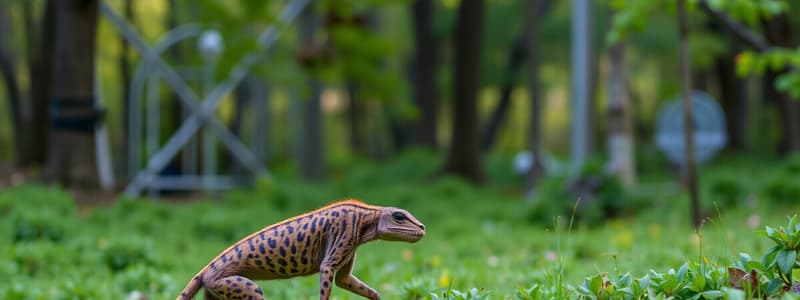Podcast
Questions and Answers
What is natural selection?
What is natural selection?
- The process where organisms better adapted to their environment tend to survive and produce more offspring (correct)
- The breeding of plants and animals for desired traits
- A random genetic change in organisms
- The development of new species
What is variation in biology?
What is variation in biology?
Any differences within a population of the same species.
What is adaptation?
What is adaptation?
Any heritable characteristic that increases an organism's ability to survive and reproduce in its environment.
What is artificial selection?
What is artificial selection?
What does the monophyletic view represent?
What does the monophyletic view represent?
What is polyphyletic?
What is polyphyletic?
What is anatomical homology?
What is anatomical homology?
What does analogous structures refer to?
What does analogous structures refer to?
What are homologous structures?
What are homologous structures?
What are vestigial structures?
What are vestigial structures?
What is embryology?
What is embryology?
What is a cladogram?
What is a cladogram?
What are the three patterns of biodiversity?
What are the three patterns of biodiversity?
What is universal common descent?
What is universal common descent?
What are the three conditions required for natural selection to occur?
What are the three conditions required for natural selection to occur?
What does intelligent design refer to?
What does intelligent design refer to?
What is evolution?
What is evolution?
How many new phyla appeared in the Cambrian explosion?
How many new phyla appeared in the Cambrian explosion?
What is the age of the Earth?
What is the age of the Earth?
Flashcards are hidden until you start studying
Study Notes
Natural Selection and Variation
- Natural selection is the process where organisms adapt to their environment, enhancing their survival and reproduction.
- Variation refers to the differences among individuals within the same species, playing a crucial role in evolution.
Adaptation and Artificial Selection
- Adaptation involves heritable characteristics that improve an organism's survival and reproductive success in its environment.
- Artificial selection is a human-driven process to breed organisms for specific traits, such as physical characteristics.
Homology and Analogy
- Anatomical homology indicates similarities in structures across different species, suggesting a common ancestry.
- Analogous structures perform the same function but arise through different evolutionary paths, such as bat wings and butterfly wings.
Structures and Evolution
- Homologous structures share a common origin but serve different functions, exemplified by bat wings versus whale flippers.
- Vestigial structures are inherited remnants from ancestors that have lost much of their original function.
Developmental Biology and Cladograms
- Embryology studies the early development stages of organisms, providing insight into evolutionary relationships.
- A cladogram is a diagram that illustrates evolutionary relationships, visualizing branching from common ancestors.
Intelligent Design and Complexity
- Intelligent design posits that some features of living organisms are best explained by an intelligent cause rather than natural selection alone.
- Irreducible complexity suggests certain biological systems cannot evolve from simpler predecessors, as their functionality relies on all parts being present.
Evolutionary Theory
- The Cambrian explosion marks a rapid increase in diverse animal forms around 530 million years ago, introducing many new phyla.
- Universal common descent suggests that all life shares a common ancestor, with evolution driven by natural selection and change over time.
Biodiversity Patterns
- Biodiversity is analyzed through local, global, and historical contexts, focusing on how species adapt to their environments.
- Two significant biogeographical patterns include the divergence of closely related species in different climates and the convergence of distantly related species in similar environments.
Fossil Record and Evolution
- The fossil record provides evidence for evolutionary expectations, showing increasing biological complexity and transitional forms leading to diverse body plans.
- Intelligent design expectations contrast with evolutionary expectations, predicting sudden increases in complexity and functional body plans.
Historical Figures in Evolution
- Charles Darwin, known for his journey on the HMS Beagle and authoring "On the Origin of Species," is a key figure in evolutionary theory.
- Ernst Haeckel's biogenetic law proposes that embryonic development mirrors evolutionary history, though problems arise from similarities observed in early stages of development.
Scientific Method and Evidence
- The scientific method comprises observation, hypothesis, experimentation, and conclusion, guiding research in evolutionary biology.
- Evidence for intelligent design includes complexity arising in biological systems and consistency with separate organizational structures.
Key Timeframes
- The Earth is estimated to be 4.56 billion years old, with life first appearing approximately 3.8 billion years ago.
- The Cambrian explosion timeline spans 335 to 540 million years ago, highlighting a significant evolutionary event with many new phyla appearing.
Studying That Suits You
Use AI to generate personalized quizzes and flashcards to suit your learning preferences.




